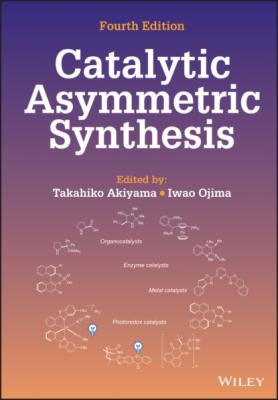Catalytic Asymmetric Synthesis. Группа авторов
Чтение книги онлайн.
Читать онлайн книгу Catalytic Asymmetric Synthesis - Группа авторов страница 59

Scheme 3.4. Enantioselective addition of β‐ketoesters to nitroalkenes catalyzed by 2c.
Source: Based on [19].
The third motif is the cinchona alkaloid‐derived catalyst having a hydrogen bond donor moiety at the C6’ position of a quinoline ring (Figure 3.4d). Cupreine (1e) and cupreidine (1f), which are the demethylated derivatives of quinine and quinidine, possess a phenoxy group at the C6’ position. In 2004, Deng and co‐workers reported that 1e, 1f, and their C9‐ether derivatives could serve as chiral bifunctional catalysts in enantioselective addition of malonates and β‐ketoesters to nitroalkenes [21]. On the other hand, Jørgensen and co‐workers reported the highly enantioselective amination of β‐dicarbonyl and related compounds with azodicarboxylates by using β‐isocupreidine (β‐ICD, 1g) as a chiral bifunctional catalyst [22]. Deng and co‐workers then proposed the transition‐state model in their report on the enantio‐ and diastereoselective addition of β‐ketoesters and the related compounds to nitroalkenes, which rationalized the stereochemical outcome (Scheme 3.5 and Figure 3.6) [23]. In the proposed model, the catalyst adopts an anti‐open conformation to activate and orient the pronucleophile and electrophile simultaneously by using a network of hydrogen bond interaction.
Scheme 3.5. Enantioselective addition of β‐ketoesters to nitroalkenes catalyzed by 1f.
Source: Based on [23].
Following from these works, several catalysts having a different C9‐ether moiety and a hydrogen bond donor unit, such as 2d, have been developed [24], although the application of this motif is somewhat limited compared to those of the other two common motifs [25].
3.2.1. Application of Designed Pronucleophiles
Following are the remarkable applications of chiral tertiary amine catalysts selected from our point of view.
The expansion of the scope of pronucleophiles is one of the most important tasks in the field of asymmetric Brønsted base catalysis because it broadens the range of accessible chiral building blocks. To this end, a variety of rationally designed pronucleophiles has been applied to the catalysis, and highly enantioselective reactions have been developed to date.
Barbas and co‐workers designed pyrazoleamides 3 as a pronucleophile and developed the enantioselective addition to nitroalkenes by using cinchona alkaloid‐urea catalyst 2e (Scheme 3.6). This is a rare example of the use of amide derivatives as pronucleophiles in chiral tertiary amine catalysis [26]. The pyrazoleamide moiety potentially functions as a good leaving group for further transformations.
Figure 3.6. Transition‐state model of Michael addition catalyzed by 1f.
Source: Based on [23].
Scheme 3.6. Enantioselective addition of pyrazoleamides 3 to nitroalkenes catalyzed by 2e. Source: Based on [26].
Malonic acid half thioesters 4 are popular as an (thio)ester enolate equivalent. As a useful application of these compounds in chiral tertiary amine catalysis, List, Song, and co‐workers reported the enantioselective decarboxylative aldol reaction with aromatic aldehydes [27]. Cinchona alkaloid‐based 2f having a sulfonamide moiety was the optimum catalyst for the reaction, and the desired products were obtained with high enantioselectivities (Scheme 3.7).
Scheme 3.7. Enantioselective aldol reaction of malonic acid half thioesters 4 catalyzed by 2f. Source: Based on [27].
On the other hand, Wennemers and co‐workers introduced mono‐thiomalonates 5 as a thioester enolate equivalent [28]. As a remarkable application of these compounds as a pronucleophile, the enantioselective synthesis of oxindoles possessing adjacent tetrasubstituted stereogenic centers was accomplished [28c]. Cinchona alkaloid‐urea catalyst 2g or Takemoto’s catalyst 2a efficiently promoted the addition of mono‐thiomalonates 5 to isatin‐derived ketimines to provide the desired oxindoles in high yields with high diastereo‐ and enantioselectivities (Scheme 3.8).
Scheme 3.8. Synthesis of oxindoles possessing adjacent tetrasubstituted stereogenic centers. Source: Based on [28c].
The same group further investigated the enantioselective reactions of fluorinated variants of malonic acid half thioesters 6 and mono‐thiomalonates, and successfully developed the decarboxylative aldol reaction and the direct Mannich‐type reaction, respectively, by using chiral bifunctional catalysts (Scheme 3.9) [29].
Scheme 3.9. Enantioselective aldol reaction of fluorinated malonic acid half thioesters 6 catalyzed by 2h.
Source: [29].